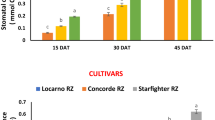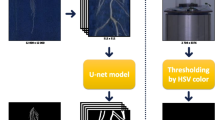Abstract
The presence of excessive amounts of heavy metals such as arsenic in the environment is a problem in many parts of the world. Many countries e.g., Bangladesh are already severely affected by arsenic contamination of soil and groundwater. Phytoaccumulation is a method in which plants are used to uptake heavy metals from soil. The genus Brassica has many species that can efficiently accumulate arsenic. Despite many studies on phytoaccumulation, little is known about the genetics of phytoaccumulation of Brassica. This study investigated the genetic effect on phytoaccumulation of arsenic in Brassica juncea L. and attempted to identify any morphological trait(s) for phytoaccumulation. Two cultivars of B. juncea namely, B. juncea cv. Rai and B. juncea cv. BARI-11 were chosen as parents for the study. A set of their morphological characteristics were selected to evaluate their potential as marker(s) for phytoaccumulation. A single concentration, 15 ppm of arsenic was used to study the genetic effect on phytoaccumulation using quantitative genetics. The results revealed that phytoaccumulation of arsenic (by the root and shoot systems) is heritable in the broad sense and polygenic in nature. The stem diameter was also found to be heritable in the broad sense and path analysis indicated that it has a significant direct effect on the shoot uptake. It is concluded that phytoaccumulation of arsenic in B. juncea (cvs. Rai and BARI-11) is a genetic phenomenon and stem diameter may be a potential marker of phytoaccumulation of arsenic in B. juncea (cvs. Rai and BARI-11).



Similar content being viewed by others
References
Akbar M, Mahmood T, Yaqub M, Anwar M, Ali M, Iqbal N (2003) Variability, correlation and path coefficient studies in summer mustard (B. juncea L). Asian J Plant Sci 2: 696–698
Akhter MS, Oki Y, Adachi T (2007) Path and correlation analysis of the factors affecting biomass production of Brassica cultivars under phosphorus deficiency stress environment. Commun Soil Sci Plant Anal 38:26–59
Ali N, Javidfar S, Elmira JY, Mirza MY (2003) Relationship among yield components and selection criteria for yield improvement in winter rape seed (Brassica napus L.). Pak J Bot 35:167–174
Allard RW (1964) Principles of plant breeding. Wiley, London 485p
Babar M, Khan AA, Arif A, Zafar Y, Arif M (2007) Path analysis of some leaf and panicle traits affecting grain yield in double haploid lines of rice (Oryza sativa L.). J Agric Res 45:245–252
Basalma D (2008) The correlation and path analysis of yield and yield components of different winter rapeseed (Brassica napus ssp. oleifera L.) cultivars. Res J Agric Biol Sci 4:120–125
BBS (Bangladesh Bureau of Statistics) (2003) Statistical yearbook of Bangladesh, 23rd edn. Ministry of Planning, Dhaka
Bhattacharrya P, Mukherjee AB, Bundschuh J, Zevenhoben R, Loeppert RH (2007) As in soil and ground water environment: biogeochemical interactions, health effects and remediation. Trace Met Other Contam Environ 9:645
Bhattacharya P, Hasan MA, Sracek O, Smith E, Ahmed KM, Bromssen M, Huq SMI, Naidu R (2009) Groundwater chemistry and arsenic mobilization in the holocene flood plains in south-central Bangladesh. Environ Geochem Health 31:23–43
Bicer BT, Sakar D (2008) Heritability and path analysis of some economical characteristics in lentil. J Central Eur Agric 9:191–196
Chaney RL (1983) Plant uptake of inorganic waste constituents. In: Parr JF, Marsh PD, Kla JM (eds) Land treatment of hazardous wastes. Park Ridge, NJ: Noyes Data, New York, pp 50–76
Chaturvedi I (2006) Effect of arsenic concentrations and forms on growth and arsenic uptake and accumulation by Indian mustard (Brassica juncea). J Central Eur Agric 7:31–40
Choudhury BR, Joshi P, Rao SR (2002) Cytogenetics of Brassica juncia × Brassica rapa hybrids and patterns of variation in the hybrid derivatives. Plant Breed 121:292–296
Clarke T (2003) Delta blues. Nature 422:254–256
Dasgan HY, Abak K, Cakmak I, Romheld V, Sensoy S (2004) Inheritance of tolerance to leaf iron deficiency chlorosis in tomato. Euphytica 139:51–57
Dhankher OP, Rosen BP, McKinney EC, Meagher RB (2006) Hyperaccumulation of arsenic in the shoot of Arabidopsis silenced for arsenate reductage. Proc Natl Acad Sci 103:5413–5418
Dhar RK, Biswash BK, Samanta G, Mandal BK, Chakraborti D, Roy S, Jafar A, Islam A, Ara GM, Kabir S (1997) Ground water arsenic calamity in Bangladesh. Curr Sci 73:48–59
Falconer DS, Mackay TFC (1996) Introduction to quantitative genetics. 4th edn. Pearson education Ltd, Essex
Fehr WR (1993) Principles of cultivar development, theory and technique, vol 1. Macmillan Publishing Company, New York, pp 536
Genc-Furham H, Tjell JC, McConchie D (2004) Increasing the arsenate adsorption capacity of neutralised red mud. J Colloid Interface Sci 271:313–320
Genc-Furham H, McConchie D, Schuiling O (2005) Comparing the arsenic sorption capacity of bauxsol and its derivatives with other sorbent. In: Bundschub, Bhattacharya and Chandrasekhram (eds) Natural arsenic in groundwater: occurrence, remediation and management. Balkema, Taylor and Francis Group, London, pp 223–235
Grill E, Winnaker EL, Zenk MH (1985) Phytochelatine: the principle heavy metal complexing peptides of higher plants. Science 230:674–676
Gupta M, Sharma P, Sarin NB, Sinha NK (2009) Differential responses of arsenic stress in two varieties of B. juncia L. Chemosphere 74(9):1201–1208
Hoagland DR, Arnon DI (1950) The water culture method of growing plants without soil. Californian agricultural experimental station. Circular 347:1–32
Hossain MF (2006) Arsenic contamination of Bangladesh—an overview. Agric Ecosyst Environ 113:1–16
Hossain MA, Islam MA, Goni MO, Karim MA (2005) Arsenic contamination in drinking water of tube wells in Bangladesh: statistical analysis and associated factors. In: Bundschub, Bhattacharya and Chandrasekhram (eds) Natural arsenic in groundwater: occurrence, remediation and management. Balkema, Taylor and Francis Group, London, pp 163–171
Kashem MA, Singh BL (1998) Heavy metal contamination of soil and vegetation in the vicinity of industries of Bangladesh. Water Air Soil Pollut 115:347–361
Kaur S, Ford R, Nicolas M, Taylor PWJ (2008) Genetics of tolerance to high concentrations of boron in Brassica rapa. Euphytica 162:31–38
Kimber DS, McGregor DI (1995) The species and their origin, cultivation and world production. In: Kimber D, McGregor DI (eds) Brassica oilseeds, production and utilization. CAB International, Wallingford, pp 1–7
Lande R (1981) The minimum number of genes contributing to quantitative variation between and within populations. Genetics 99:541–553
Mahmood T, Rahman MH, Stringham GR, Yeh F, Good F (2005) Molecular markers for yield components in Brassica juncea—do these assist in breeding for high seed yield? Euphytica 144:157–167
Mahmud I, Kramar HH (1951) Segregation for yield, height and maturity following a soybean cross. Agron J 43:605–609
Naidu R, Bhattacharya P (2006) Management and remediation of arsenic from contaminated water. In: Naidu R, Smith E, Owens G, Bhattacharya P, Nadebaum P (eds) Managing arsenic in the environment: from soil to human health. CSIRO publishing, Melbourne, pp 327–350
Naidu R, Smith E, Owens G, Bhattacharya P, Nadebaum P (2006) Managing arsenic in the environment: from soil to in the environment: from soil to human health. CSIRO publishing, Melbourne, p 565p
Pilon-smits E (2005) Phytoremediation. Annu Rev Plant Biol 56:15–39
Pollard AJ, Baker AJM (1996) The quantitative genetics of zinc hyperaccumulation in Thalspi caerulescense. New Phytol 132:113–118
Prakash S (1980) Cruciferous oilseeds in India. In: Tsunoda S et al. (eds) Brassica crops and wild allies, biology and breeding. pp 151–166
Prasad MNV (2006) Plants that accumulate and/or exclude toxic trace elements play an important role in phytoremediation. In: Prasad MNV (ed) Trace element in the environment. Taylor and Francis Group, LLC, Boca Raton, pp 524–547
Prasad MNV, Freitas HMDO (2003) Metal hyperaccumulation in plants-biodiversity prospecting for phytoremediation technology. Mol Biol Genet 6:25–42
Rahman MA, Hossain MD, Islam MS, Biswas DK, Ahiduzzaman M (2002) Genetic variability, heritability and path analysis in snake gourd (Trichosanthes anguina L.). Pak J Biol Sci 5:284–286
Rahman MM, Naidu R, Bhattacharya P (2009) Arsenic contamination in groundwater in the southeast Asia region. Environ Geochem Health 31:9–21
Salt DE, Blaylock M, Kumar PBAN, Dushenkov V, Ensley BD, Chet L, Raskin L (1995) Phytoremediation: a novel strategy for the removal of toxic metals from the environment using plants. Biotechnology 13:468–474
Salt DE, Smith RD, Raskin I (1998) Phytoremediation. Annu Rev Plant Physiol Plant Mol Biol 49:643–668
Schmoger MEV, Oven M, Grill E (2000) Detoxification of arsenic by phytochelatins in plants. Plant Physiol 122:793–801
Conflict of interest
The authors declare no conflict of interest.
Author information
Authors and Affiliations
Corresponding author
Rights and permissions
About this article
Cite this article
Rahman, M., Haq, N. & Williams, I.D. Genetic effect on phytoaccumulation of arsenic in Brassica juncea L. Euphytica 186, 409–417 (2012). https://doi.org/10.1007/s10681-012-0632-1
Received:
Accepted:
Published:
Issue Date:
DOI: https://doi.org/10.1007/s10681-012-0632-1




